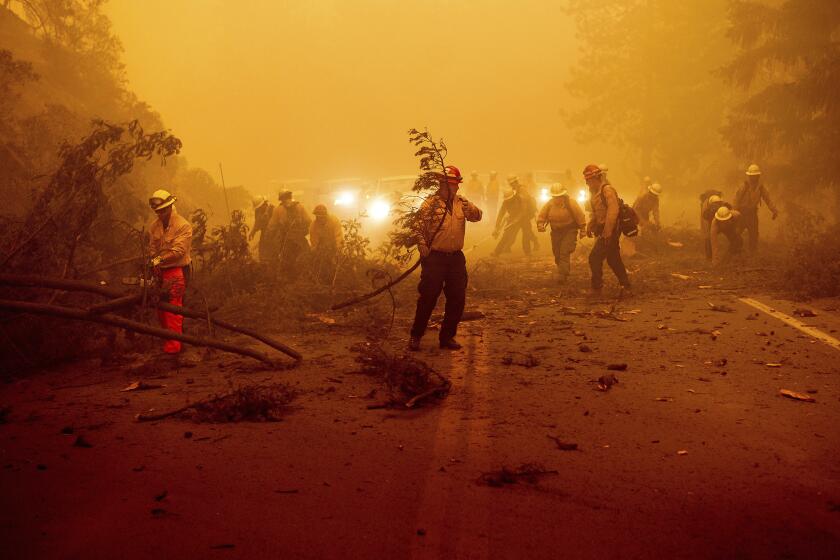Editorial: California’s overstuffed ballot is a complicated mess. Allow us to clear up some confusion.

California’s online voter-registration record was shattered this year when more people signed up on a single day than ever before. Almost 300,000 people registered online to vote on Oct. 24, the last day to do so. A majority of them were young voters, according to the Secretary of State, many presumably galvanized by the historically nasty presidential campaign to cast a vote for Donald Trump or Hillary Clinton.
But what do these Johnny-come-lately voters know about revenue bonds or retailers’ paper bag carryout fees? Are they well versed in the best methods of teaching non-English-speaking second-graders or the state’s prescription drug procurement process or the hospital fees that help fund Medi-Cal?
Of course not. They’re not a collection of policy wonks; they’re ordinary people. And so are most California voters. Yet after making their choices for president and other offices, they all will face 17 complicated, complex and in some cases life-changing propositions on the Nov. 8 ballot. This is more measures than have appeared on a single statewide ballot since 2000 — and that’s not even counting the equally long or longer list of local ballot measures in some cities and counties.
The inevitable outcome of such an overstuffed ballot is confusion for new and longtime voters alike.
The inevitable outcome of such an overstuffed ballot is confusion for new and longtime voters alike. Data from a recent polling experiment by Capitol Weekly confirms this. Pollsters asked 2,637 likely voters between late September and mid-October to fill out one of three different versions of a sample statewide ballot to see what happened when the measures were presented in different ways. They also asked big-picture questions about the propositions to gauge how much understanding voters had about what their votes meant.
The findings for the most part were dispiriting. Voting dropped off near the end of longer ballots, and many voters were undecided about technical or complicated measures, such as Proposition 53, the measure that would require a statewide vote on certain revenue bonds, and Proposition 52, the tax on hospitals to raise money for Medi-Cal.
Follow-up questions revealed additional disturbing details about situations where there were more than one proposition on the same topic. It seems voters aren’t always clear on the differences.
For example, pollsters found that 40% of the people who say they support ending the death penalty (which would be accomplished by Proposition 62) voted “yes” on Proposition 66, which proposes something else entirely: It would speed up executions, primarily by shortening the appeals process.
In another case, more than half of the respondents said they had voted “against increased taxes,” but half of that group had voted “yes” for Proposition 56, the $2-a-pack tobacco tax. And 38% of that group voted for Proposition 55 — which would extend taxes on wealthy Californians.
Then there was confusion over the two measures bankrolled by the plastic bag industry, Propositions 65 and 67.
Proposition 67 is a referendum on a law passed by the Legislature two years ago forbidding retailers from handing out single-use plastic bags and requiring them to collect a fee of at least 10 cents for paper carryout bags. Retailers are allowed to keep the revenue to cover the cost of the paper bags and to pay for their efforts to educate consumers about the plastic bag ban. For obvious reasons, plastic bag makers did not like the new law and spent millions of dollars to put the issue to a referendum. Unless a majority of voters affirm the law with a “yes” vote, it will be repealed.
Proposition 65 is a related measure, also put on by the plastic bag industry. It says that if Proposition 67 passes, the revenue from the paper bag fees must be directed into a wildlife conservation fund. That sounds environmentally friendly — all that money could help, say, clean up plastic bag litter from beaches and rivers. Yet a number of environmental groups such as Heal the Bay and the Natural Resources Defense Council oppose Proposition 65 because they say it is a red herring by the plastic bag industry to confuse voters and to take the money away from grocers that is needed to implement the plastic bag ban.
If the purpose was to confuse, it seems to have worked. The poll found that 68% of voters who endorsed Prop. 65 thought they were voting against the plastic bag industry’s wishes. And another 12% thought that by voting “no” on Proposition 67 thought they were sticking it to plastic bag industry. In both cases, they’re wrong.
The good news, if it could be characterized as such, is that when voters get confused or the ballot is too long, they are less likely to vote “yes” or even vote at all. That means there’s a certain amount of self-correction when it comes to propositions too flawed to be well understood. On the other hand, it bodes ill for worthwhile measures that are inherently complex — and for good propositions stuck near the end of the ballot, such as the plastic bag ban.
That’s a shame, but unavoidable in a system in which all it takes to get a proposition on the ballot is an idea and a willingness to spend a few million dollars on lawyers and signature gatherers.
To see The Times’ recommendations for this year’s ballot measures, visit latimes.com/endorsements.
Follow the Opinion section on Twitter @latimesopinion and Facebook
More to Read
A cure for the common opinion
Get thought-provoking perspectives with our weekly newsletter.
You may occasionally receive promotional content from the Los Angeles Times.










